what structures are jaws thought to have evolved from?
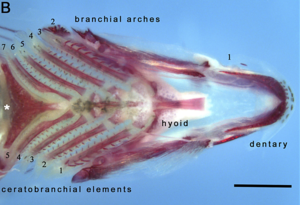
Dorsal view of the lower pharyngeal and oral jaws of a juvenile Malawi eyebiter showing the branchial (pharyngeal) arches and ceratobrachial elements (arch basic). The white asterisk indicates the toothed pharyngeal jaw. Scale bar represents 500 μm.[1]
Near bony fishes have two sets of jaws made mainly of os. The primary oral jaws open and close the oral fissure, and a 2d prepare of pharyngeal jaws are positioned at the dorsum of the pharynx. The oral jaws are used to capture and manipulate prey by bitter and crushing. The pharyngeal jaws, so-chosen considering they are positioned within the pharynx, are used to further process the food and move it from the mouth to the tum.[two] [three]
Cartilaginous fishes, such every bit sharks and rays, have 1 ready of oral jaws made mainly of cartilage. They do non take pharyngeal jaws. Mostly jaws are articulated and oppose vertically, comprising an upper jaw and a lower jaw and can bear numerous ordered teeth. Cartilaginous fishes grow multiple sets (polyphyodont) and replace teeth as they wear by moving new teeth laterally from the medial jaw surface in a conveyor-belt fashion. Teeth are replaced multiple times as well in virtually bony fishes, but dissimilar cartilaginous fishes, the new tooth erupts simply after the old one has fallen out.
Jaws probably originated in the pharyngeal arches supporting the gills of jawless fish. The earliest jaws appeared in at present extinct placoderms and spiny sharks during the Silurian, about 430 1000000 years agone. The original selective advantage offered by the jaw was probably not related to feeding, but to increased respiration efficiency—the jaws were used in the buccal pump to pump water beyond the gills. The familiar utilize of jaws for feeding would and then take developed every bit a secondary function before condign the principal role in many vertebrates. All vertebrate jaws, including the human jaw, evolved from early fish jaws. The appearance of the early vertebrate jaw has been described equally "perchance the most profound and radical evolutionary step in the vertebrate history".[four] [five] Fish without jaws had more than difficulty surviving than fish with jaws, and about jawless fish became extinct.
Jaws use linkage mechanisms. These linkages can be specially common and complex in the head of bony fishes, such equally wrasses, which have evolved many specialized feeding mechanisms. Especially advanced are the linkage mechanisms of jaw protrusion. For suction feeding a system of linked four-bar linkages is responsible for the coordinated opening of the mouth and the 3-dimensional expansion of the buccal cavity. The four-bar linkage is as well responsible for protrusion of the premaxilla,[6] leading to three master 4-bar linkage systems to by and large describe the lateral and anterior expansion of the buccal crenel in fishes.[vi] [7] The near thorough overview of the dissimilar types of linkages in animals has been provided by Chiliad. Muller,[8] who also designed a new classification arrangement, which is especially well suited for biological systems.
Skull [edit]
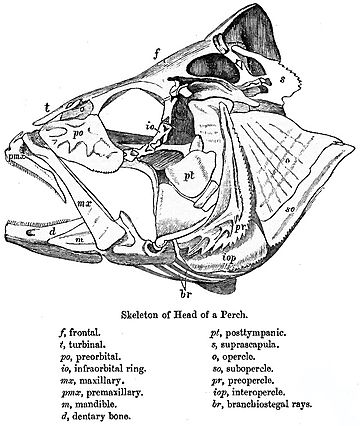
The skull of fishes is formed from a series of loosely continued bones. Lampreys and sharks simply possess a cartilaginous endocranium, with both the upper and lower jaws being separate elements. Bony fishes have additional dermal bone, forming a more than or less coherent skull roof in lungfish and holost fish.
The simpler construction is found in jawless fish, in which the cranium is represented by a trough-like basket of cartilaginous elements only partially enclosing the brain, and associated with the capsules for the inner ears and the unmarried nostril.[nine]
Cartilaginous fish, such as sharks, also have simple skulls. The attic is a single structure forming a case effectually the brain, enclosing the lower surface and the sides, but always at least partially open at the top equally a large fontanelle. The most anterior part of the cranium includes a forward plate of cartilage, the rostrum, and capsules to enclose the olfactory organs. Backside these are the orbits, and so an additional pair of capsules enclosing the structure of the inner ear. Finally, the skull tapers towards the rear, where the foramen magnum lies immediately above a single condyle, articulating with the kickoff vertebra. At that place are, in addition, at various points throughout the cranium, smaller foramina for the cranial fretfulness. The jaws consist of separate hoops of cartilage, almost always distinct from the cranium proper.[9]
In ray-finned fishes, there has also been considerable modification from the primitive pattern. The roof of the skull is more often than not well formed, and although the exact relationship of its bones to those of tetrapods is unclear, they are usually given similar names for convenience. Other elements of the skull, however, may be reduced; there is footling cheek region behind the enlarged orbits, and footling, if whatsoever bone in betwixt them. The upper jaw is often formed largely from the premaxilla, with the maxilla itself located further dorsum, and an additional os, the symplectic, linking the jaw to the rest of the cranium.[9]
Although the skulls of fossil lobe-finned fish resemble those of the early on tetrapods, the same cannot exist said of those of the living lungfishes. The skull roof is not fully formed, and consists of multiple, somewhat irregularly shaped basic with no direct human relationship to those of tetrapods. The upper jaw is formed from the pterygoids and vomers lonely, all of which conduct teeth. Much of the skull is formed from cartilage, and its overall construction is reduced.[nine]
Oral jaws [edit]
Lower [edit]

In vertebrates, the lower jaw (mandible or jawbone)[10] is a bone forming the skull with the cranium. In lobe-finned fishes and the early fossil tetrapods, the bone homologous to the mandible of mammals is merely the largest of several basic in the lower jaw. It is referred to every bit the dentary os, and forms the trunk of the outer surface of the jaw. Information technology is bordered below past a number of splenial basic, while the angle of the jaw is formed by a lower athwart bone and a suprangular bone just above it. The inner surface of the jaw is lined by a prearticular bone, while the articular os forms the joint with the skull proper. Finally a ready of three narrow coronoid bones lie to a higher place the prearticular os. Every bit the name implies, the majority of the teeth are attached to the dentary, just there are commonly also teeth on the coronoid bones, and sometimes on the prearticular besides.[11]
This circuitous primitive blueprint has, all the same, been simplified to diverse degrees in the corking majority of vertebrates, as bones have either fused or vanished entirely. In teleosts, only the dentary, articular, and angular bones remain.[eleven] Cartilaginous fish, such as sharks, practice not have any of the bones found in the lower jaw of other vertebrates. Instead, their lower jaw is composed of a cartilaginous structure homologous with the Meckel'south cartilage of other groups. This also remains a significant element of the jaw in some archaic bony fish, such as sturgeons.[11]
Upper [edit]
The upper jaw, or maxilla[12] [13] is a fusion of two bones along the palatal fissure that form the upper jaw. This is similar to the mandible (lower jaw), which is as well a fusion of two halves at the mandibular symphysis. In bony fish, the maxilla is called the "upper maxilla," with the mandible existence the "lower maxilla". The alveolar process of the maxilla holds the upper teeth, and is referred to as the maxillary arch. In almost vertebrates, the foremost part of the upper jaw, to which the incisors are fastened in mammals consists of a split up pair of basic, the premaxillae. In bony fish, both maxilla and premaxilla are relatively plate-like bones, forming only the sides of the upper jaw, and part of the confront, with the premaxilla also forming the lower boundary of the nostrils.[14] Cartilaginous fish, such equally sharks and rays besides lack a true maxilla. Their upper jaw is instead formed from a cartilagenous bar that is not homologous with the bone establish in other vertebrates.[14]
Some fish accept permanently protruding upper jawbones chosen rostrums. Billfish (marlin, swordfish and sailfish) use rostrums (bills) to slash and stun prey. Paddlefish, goblin sharks and hammerhead sharks have rostrums packed with electroreceptors which point the presence of prey by detecting weak electrical fields. Sawsharks and the critically endangered sawfish have rostrums (saws) which are both electro-sensitive and used for slashing.[fifteen] The rostrums extend ventrally in front end of the fish. In the case of hammerheads the rostrum (hammer) extends both ventrally and laterally (sideways).
- Fish with rostrums (extended upper jawbones)
-

Sailfish, similar all billfish, take a rostrum (bill) which evolved from the upper jawbone
-

Sawfish accept an electro-sensitive rostrum (saw) which is as well used to slash at prey
Jaw protrusion [edit]
Teleosts have a movable premaxilla (a bone at the tip of the upper jaw) and respective modifications in the jaw musculature which get in possible for them to protrude their jaws outwards from the oral fissure. This is of great reward, enabling them to grab prey and draw information technology into the mouth. In more derived teleosts, the enlarged premaxilla is the main molar-bearing os, and the maxilla, which is fastened to the lower jaw, acts equally a lever, pushing and pulling the premaxilla equally the rima oris is opened and closed. These protrusible jaws are evolutionary novelties in teleosts that evolved independently at least five times.[16]
The premaxilla is unattached to the neurocranium (braincase); it plays a role in protruding the oral fissure and creating a round opening. This lowers the pressure within the rima oris, sucking the prey inside. The lower jaw and maxilla (chief upper fixed bone of the jaw) are then pulled dorsum to shut the rima oris, and the fish is able to grasp the prey. By contrast, mere closure of the jaws would run a risk pushing nutrient out of the mouth. In more advanced teleosts, the premaxilla is enlarged and has teeth, while the maxilla is toothless. The maxilla functions to push both the premaxilla and the lower jaw forward. To open the oral fissure, an adductor muscle pulls back the elevation of the maxilla, pushing the lower jaw forward. In addition, the maxilla rotates slightly, which pushes forward a bony procedure that interlocks with the premaxilla.[17]
Teleosts accomplish this jaw protrusion using one of four different mechanisms involving the ligamentous linkages within the skull.[xviii]
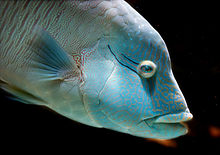

- Mandibular depression mechanism: The depression of the lower jaw (mandible) pulls or pushes the premaxilla into protrusion via force transmission through ligaments and tendons continued to the upper jaws (east.k. Cyprinus, Labrus).[18] This is the most commonly used mechanism.
- Twisting maxilla mechanism: The depression of the mandible causes the maxilla to twist most the longitudinal centrality resulting in the protrusion of the premaxilla (e.one thousand. Mugil).[18]
- Decoupled mechanism: Protrusion of the premaxilla is accomplished through top of the neurocranium causing the premaxilla to movement anteriorly. Movements of the neurocranium are non coupled with the kinematics of the upper jaw (east.yard. Spathodus erythrodon),[18] [19] assuasive for more versatility and modularity of the jaws during prey capture and manipulation.
- Suspensorial abduction mechanism: The lateral expansion of the suspensorium (a combination of the palatine, pterygoid series, and quadrate basic) pulls on a ligament which causes the premaxilla to protrude anteriorly (due east.g. Petrotilapia tridentiger).[eighteen] [19]
Some teleosts use more than one of these mechanisms (e.grand. Petrotilapia).[18]
Wrasses accept become a principal study species in fish-feeding biomechanics due to their jaw structure. They accept protractile mouths, ordinarily with dissever jaw teeth that jut outwards.[20] Many species tin can exist readily recognized by their thick lips, the inside of which is sometimes curiously folded, a peculiarity which gave rise the German language name of "lip-fishes" (Lippfische).[21]
The nasal and mandibular bones are connected at their posterior ends to the rigid neurocranium, and the superior and inferior articulations of the maxilla are joined to the anterior tips of these 2 bones, respectively, creating a loop of 4 rigid bones connected by moving joints. This "four-bar linkage" has the holding of assuasive numerous arrangements to achieve a given mechanical effect (fast jaw protrusion or a forceful bite), thus decoupling morphology from role. The bodily morphology of wrasses reflects this, with many lineages displaying different jaw morphology that results in the aforementioned functional output in a like or identical ecological niche.[twenty]
The most extreme jaw protrusion plant in fishes occurs in the slingjaw wrasse, Epibulus insidiator . This fish can extend its jaws upwards to 65% the length of its head.[22] This species utilizes its quick and extreme jaw protrusion to capture smaller fishes and crustaceans. The genus this species belongs to possess ane unique ligament (vomero-interopercular) and ii enlarged ligaments (interoperculo-mandibular and premaxilla-maxilla), which along with a few changes to the form of cranial basic, allow it to accomplish extreme jaw protrusion.
Pharyngeal jaws [edit]

Moray eels accept two sets of jaws: the oral jaws that capture prey and the pharyngeal jaws that advance into the oral cavity and move prey from the oral jaws to the esophagus for swallowing
Pharyngeal jaws are a second fix of jaws distinct from the chief (oral) jaws. They are contained inside the throat, or pharynx, of most bony fish. They are believed to take originated, in a like way to oral jaws, every bit a modification of the fifth gill arch which no longer has a respiratory function. The first 4 arches yet function as gills. Dissimilar the oral jaw, the pharyngeal jaw has no jaw joint, but is supported instead by a sling of muscles.

A notable example occurs with the moray eel. The pharyngeal jaws of most fishes are not mobile. The pharyngeal jaws of the moray are highly mobile, perchance as an accommodation to the constricted nature of the burrows they inhabit which inhibits their ability to swallow as other fishes practise by creating a negative pressure in the mouth. Instead, when the moray bites prey, it outset bites commonly with its oral jaws, capturing the prey. Immediately thereafter, the pharyngeal jaws are brought frontwards and seize with teeth downwardly on the prey to grip it; they then retract, pulling the prey down the moray eel's gullet, allowing information technology to be swallowed.[23]
All vertebrates accept a pharynx, used in both feeding and respiration. The throat arises during development through a series of half-dozen or more than outpocketings chosen pharyngeal arches on the lateral sides of the caput. The pharyngeal arches requite ascent to a number of dissimilar structures in the skeletal, muscular and circulatory systems in a style which varies across the vertebrates. Pharyngeal arches trace back through chordates to basal deuterostomes who also share endodermal outpocketings of the pharyngeal appliance. Similar patterns of gene expression can exist detected in the developing throat of amphioxus and hemichordates. Withal, the vertebrate pharynx is unique in that it gives rise to endoskeletal support through the contribution of neural crest cells.[24]
Cartilaginous jaws [edit]
Cartilaginous fishes (sharks, rays and skates) have cartilaginous jaws. The jaw's surface (in comparison to the vertebrae and gill arches) needs extra strength due to its heavy exposure to physical stress. It has a layer of tiny hexagonal plates chosen "tesserae", which are crystal blocks of calcium salts arranged as a mosaic.[25] This gives these areas much of the same strength found in the bony tissue found in other animals.
More often than not sharks have only i layer of tesserae, but the jaws of big specimens, such every bit the bull shark, tiger shark, and the cracking white shark, have two to three layers or more, depending on body size. The jaws of a large swell white shark may have up to five layers.[26] In the rostrum (snout), the cartilage can be spongy and flexible to blot the power of impacts.
In sharks and other extant elasmobranchs the upper jaw is not fused to the cranium, and the lower jaw is articulated with the upper. The organization of soft tissue and whatsoever boosted articulations connecting these elements is collectively known as the jaw pause. There are several archetypal jaw suspensions: amphistyly, orbitostyly, hyostyly, and euhyostyly. In amphistyly, the palatoquadrate has a postorbital articulation with the chondrocranium from which ligaments primarily append it anteriorly. The hyoid articulates with the mandibular curvation posteriorly, simply it appears to provide fiddling support to the upper and lower jaws. In orbitostyly, the orbital process hinges with the orbital wall and the hyoid provides the majority of suspensory support. In contrast, hyostyly involves an ethmoid articulation between the upper jaw and the attic, while the hyoid about likely provides vastly more than jaw support compared to the anterior ligaments. Finally, in euhyostyly, as well known as true hyostyly, the mandibular cartilages lack a ligamentous connectedness to the attic. Instead, the hyomandibular cartilages provide the only means of jaw support, while the ceratohyal and basihyal elements articulate with the lower jaw, but are disconnected from the remainder of the hyoid.[27] [28] [29]
Teeth [edit]
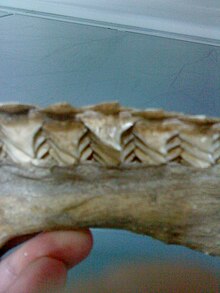
Inside of a shark jaw where new teeth motion forward every bit though on a conveyor belt
Jaws provide a platform in almost fishes for uncomplicated pointed teeth. Lungfish and chimaera have teeth modified into broad enamel plates with jagged ridges for crushing or grinding. Carp and loach have pharyngeal teeth only. Sea horses, pipefish and developed sturgeon have no teeth of any blazon. In fish, Hox gene expression regulates mechanisms for tooth initiation.[xxx] [31]
However, sharks continuously produce new teeth throughout their lives via a drastically unlike machinery.[32] [33] [34] Shark teeth form from modified scales well-nigh the tongue and movement outward on the jaw in rows until they are somewhen dislodged.[35] Their scales, called dermal denticles, and teeth are homologous organs.[36]
Shark teeth are embedded in the gums rather than directly affixed to the jaw, and are constantly replaced throughout life. Multiple rows of replacement teeth abound in a groove on the inside of the jaw and steadily moving forward as though on a conveyor belt. Some sharks lose 30,000 or more teeth in their lifetime. The rate of tooth replacement varies from once every 8 to 10 days to several months. In most species, teeth are replaced i at a time as opposed to the simultaneous replacement of an entire row, which is observed in the cookiecutter shark.[37]
Tooth shape depends on the shark'southward diet: those that feed on mollusks and crustaceans accept dense and flattened teeth used for crushing, those that feed on fish have needle-similar teeth for gripping, and those that feed on larger casualty such as mammals have pointed lower teeth for gripping and triangular upper teeth with serrated edges for cut. The teeth of plankton-feeders such as the basking shark are small and non-functional.[38]
- Cartilaginous jaws and their teeth
-

The thornback ray has teeth adjusted to feed on crabs, shrimps and small fish.
-

Tiger shark teeth are oblique and serrated to saw through flesh
-

The prickly shark has knife-like teeth with primary cusps flanked by lateral cusplets
Examples [edit]
Salmon [edit]

Open mouth of a salmon showing the second fix of pharyngeal jaws positioned at the back of the pharynx
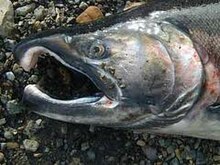
Kype of a spawning male salmon
Male salmon often remodel their jaws during spawning runs so they accept a pronounced curvature. These hooked jaws are called kypes. The purpose of the kype is non birthday clear, though they tin be used to institute dominance by clamping them around the base of the tail (caudal peduncle) of an opponent.[39] [40]
Cichlids [edit]

Dorsal view of right-bending (left) and left-angle (correct) jaw morphs[41]
Fish jaws, like vertebrates in general, ordinarily testify bilateral symmetry. An exception occurs with the parasitic calibration-eating cichlid Perissodus microlepis. The jaws of this fish occur in two singled-out morphological forms. One morph has its jaw twisted to the left, allowing information technology to swallow scales more readily on its victim's right flank. The other morph has its jaw twisted to the correct, which makes it easier to swallow scales on its victim'due south left flank. The relative abundance of the two morphs in populations is regulated by frequency-dependent selection.[41] [42] [43]
In cichlids generally, the oral and pharyngeal teeth differ with unlike species in ways that let them to procedure different kinds of prey. Chief oral jaws contain teeth which are used to capture and hold food, while pharyngeal jaws have pharyngeal teeth which office equally a chewing tool.
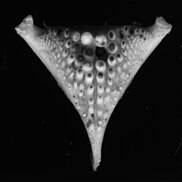

This allows for unlike nutritional strategies, and considering of this, cichlids are able to colonize different habitats. The structural multifariousness of the lower pharyngeal jaw could be one of the reasons for the occurrence of so many cichlid species. Convergent development took place over the course of the cichlid radiation, synchronous with different trophic niches.[44] The pharyngeal jaw apparatus consists of two upper and one single lower plate, all of which have dentations that differ in size and type.[45] The construction of the lower throat is ofttimes associated with the species of food of the species.[46]
In guild to crack shellfish considerable strength must be generated, which is why cichlids that feed on molluscs (e.m. the cichlid bass, Crenicichla minuano), take molariform teeth and a strengthened jawbone os. To grab and seize with teeth prey not armoured with shells, predators demand conical, bent back teeth.[47] Herbivorous cichlids too have structural differences in their teeth. Cichlids that specialise in algae (e.g. Pseudotropheus) tend to have small conical teeth. Species that feed on pods or seeds require big conical teeth for chewing their nutrient.[48]
Other [edit]

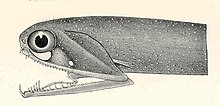
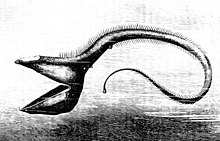
Stoplight loosejaws are pocket-size fish found worldwide in the deep sea. Relative to their size they take one of the widest gapes of any fish. The lower jaw has no ethmoid membrane (floor) and is attached simply by the hinge and a modified natural language bone. There are several large, fang-like teeth in the forepart of the jaws, followed by many small spinous teeth. There are several groups of pharyngeal teeth that serve to straight food down the esophagus.[49] [50]
Another deep body of water fish, the pelican eel, has jaws larger than its body. The jaws are lined with minor teeth and are loosely hinged. They open broad enough to consume a fish larger than the eel itself.
Distichodontidae are a family of fresh water fishes which can be divided into genera with protractile upper jaws which are carnivores, and genera with nonprotractile upper jaws which are herbivores or predators of very small organisms.[51]
Evolution [edit]
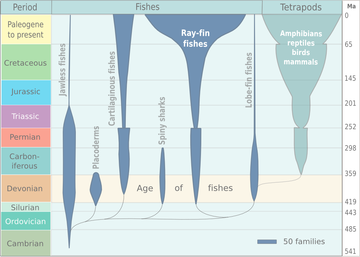
Spindle diagram for the evolution of fish and other vertebrate classes.[52] The earliest classes that developed jaws were the now extinct placoderms and the spiny sharks.
The appearance of the early vertebrate jaw has been described as "a crucial innovation"[53] and "perchance the almost profound and radical evolutionary step in the vertebrate history".[4] [five] Fish without jaws had more difficulty surviving than fish with jaws, and most jawless fish became extinct during the Triassic catamenia. Notwithstanding studies of the cyclostomes, the jawless hagfishes and lampreys that did survive, have yielded fiddling insight into the deep remodelling of the vertebrate skull that must take taken place as early jaws evolved.[54] [55]
The customary view is that jaws are homologous to the gill arches.[56] In jawless fishes a series of gills opened behind the mouth, and these gills became supported by cartilaginous elements. The get-go set of these elements surrounded the mouth to class the jaw. The upper portion of the second embryonic curvation supporting the gill became the hyomandibular bone of jawed fishes, which supports the skull and therefore links the jaw to the cranium.[57] The hyomandibula is a gear up of bones found in the hyoid region in most fishes. Information technology usually plays a function in suspending the jaws or the operculum in the case of teleosts.[58]
It is at present accepted that the precursors of the jawed vertebrates are the long extinct bony (armoured) jawless fish, the so-called ostracoderms.[59] [60] The earliest known fish with jaws are the now extinct placoderms[61] and spiny sharks.[62]
Placoderms were a class of fish, heavily armoured at the front of their torso, which first appeared in the fossil records during the Silurian nigh 430 million years ago. Initially they were very successful, diversifying remarkably during the Devonian. They became extinct by the end of that menstruum, nearly 360 million years ago.[63] Their largest species, Dunkleosteus terrelli, measured up to 10 m (33 ft)[64] [65] and weighed three.six t (4.0 short tons).[66] It possessed a four bar linkage mechanism for jaw opening that incorporated connections between the skull, the thoracic shield, the lower jaw and the jaw muscles joined together by movable joints.[67] [68] This machinery allowed Dunkleosteus terrelli to accomplish a loftier speed of jaw opening, opening their jaws in 20 milliseconds and completing the whole procedure in l-threescore milliseconds, comparable to modern fishes that employ suction feeding to assist in prey capture.[67] They could besides produce high bite forces when closing the jaw, estimated at vi,000 N (1,350 lbf) at the tip and 7,400 North (1,660 lbf) at the bract edge in the largest individuals.[68] The pressures generated in those regions were high plenty to puncture or cutting through cuticle or dermal armour[67] suggesting that Dunkleosteus terrelli was perfectly adjusted to prey on free-pond, armoured casualty like arthropods, ammonites, and other placoderms.[68]
Spiny sharks were another form of fish which appeared also in the fossil records during the Silurian at about the same time as the placoderms. They were smaller than nearly placoderms, usually under 20 centimetres. Spiny sharks did non diversify as much as placoderms, simply survived much longer into the Early Permian well-nigh 290 1000000 years ago.[69]
The original selective advantage offered by the jaw may not be related to feeding, merely rather to increased respiration efficiency.[70] The jaws were used in the buccal pump even so observable in modern fish and amphibians, that uses "animate with the cheeks" to pump water across the gills of fish or air into the lungs in the case of amphibians. Over evolutionary time the more familiar use of jaws (to humans), in feeding, was selected for and became a very important part in vertebrates. Many teleost fish have substantially modified jaws for suction feeding and jaw protrusion, resulting in highly complex jaws with dozens of bones involved.[71]
Jaws are thought to derive from the pharyngeal arches that support the gills in fish. The ii most anterior of these arches are thought to accept get the jaw itself (see hyomandibula) and the hyoid arch, which braces the jaw against the braincase and increases mechanical efficiency. While in that location is no fossil prove direct to support this theory, it makes sense in lite of the numbers of pharyngeal arches that are visible in extant jawed (the Gnathostomes), which have seven arches, and archaic jawless vertebrates (the Agnatha), which have nine.
Meckel's cartilage is a piece of cartilage from which the mandibles (lower jaws) of vertebrates evolved. Originally it was the lower of two cartilages which supported the first gill arch (nearest the front end) in early fish. Then it grew longer and stronger, and caused muscles capable of closing the developing jaw.[72] In early fish and in chondrichthyans (cartilaginous fish such as sharks), Meckel's cartilage continued to exist the main component of the lower jaw. But in the developed forms of osteichthyans (bony fish) and their descendants (amphibians, reptiles, birds and mammals) the cartilage was covered in bone – although in their embryos the jaw initially develops as the Meckel's cartilage. In tetrapods the cartilage partially ossifies (changes to bone) at the rear end of the jaw and becomes the articular bone, which forms role of the jaw joint in all tetrapods except mammals.[72]
See also [edit]
- Cranial kinesis
- DLX gene family
- Entelognathus primordialis
- Glossohyal
- Hox gene
- Hyomandibula
- Palatoquadrate
Notes [edit]
- ^ a b Fraser, One thousand. J.; Hulsey, C. D.; Bloomquist, R. F.; Uyesugi, K.; Manley, Northward. R.; Streelman, J. T. (2009). "An ancient gene network is co-opted for teeth on old and new jaws". PLOS Biology. 7 (2): e1000031. doi:ten.1371/journal.pbio.1000031. PMC2637924. PMID 19215146.
- ^ Mabuchi, K.; Miya, M.; Azuma, Y.; Nishida, M. (2007). "Contained evolution of the specialized pharyngeal jaw appliance in cichlid and labrid fishes". BMC Evolutionary Biology. 7 (1): x. doi:10.1186/1471-2148-7-10. PMC1797158. PMID 17263894.
- ^ Alfaro, M. E.; Brock, C. D.; Banbury, B. L.; Wainwright, P. C. (2009). "Does evolutionary innovation in pharyngeal jaws pb to rapid lineage diversification in labrid fishes?". BMC Evolutionary Biology. 9 (1): 255. doi:10.1186/1471-2148-9-255. PMC2779191. PMID 19849854.
- ^ a b Gai, Z.; Zhu, Yard. (2012). "The origin of the vertebrate jaw: Intersection between developmental biological science-based model and fossil evidence". Chinese Science Bulletin. 57 (xxx): 3819–3828. Bibcode:2012ChSBu..57.3819G. doi:10.1007/s11434-012-5372-z.
- ^ a b Maisey, J. Chiliad. (2000). Discovering Fossil Fishes. Westview Press. pp. 1–223. ISBN978-0-8133-3807-1.
- ^ a b Westneat, Mark W. (September 1990). "Feeding mechanics of teleost fishes (Labridae; Perciformes): A test of four-bar linkage models". Periodical of Morphology. 205 (3): 269–295. doi:ten.1002/jmor.1052050304. PMID 29865760. S2CID 46933606.
- ^ Olsen, Aaron K.; Camp, Ariel 50.; Brainerd, Elizabeth L. (15 Dec 2017). "The opercular rima oris-opening machinery of largemouth bass functions as a 3D four-bar linkage with three degrees of freedom". Journal of Experimental Biology. 220 (24): 4612–4623. doi:10.1242/jeb.159079. PMID 29237766.
- ^ Muller, M (29 May 1996). "A novel classification of planar four-bar linkages and its application to the mechanical assay of animal systems". Philosophical Transactions of the Royal Society of London. Series B: Biological Sciences. 351 (1340): 689–720. Bibcode:1996RSPTB.351..689M. doi:10.1098/rstb.1996.0065. PMID 8927640.
- ^ a b c d Romer & Parsons 1977, pp. 173–177
- ^ The mandible is also in some sources still referred to as the inferior maxillary bone, though this is an outdated term which goes back to at least the 1858 starting time edition of Gray's Anatomy, if not earlier.
- ^ a b c Romer & Parsons 1977, pp. 244–247
- ^ OED 2nd edition, 1989.
- ^ "maxilla". Merriam-Webster Online Lexicon.
- ^ a b Romer & Parsons 1977, pp. 217–243
- ^ Wueringer, B. E.; Squire, 50., Jr; Kajiura, Due south. M.; Hart, Due north. S.; Collin, South. P. (2012). "The office of the sawfish's saw". Current Biology. 22 (v): R150–R151. doi:x.1016/j.cub.2012.01.055. PMID 22401891.
- ^ Westneat, G. W. (ane Nov 2004). "Evolution of Levers and Linkages in the Feeding Mechanisms of Fishes". Integrative and Comparative Biology. 44 (5): 378–389. doi:10.1093/icb/44.5.378. PMID 21676723.
- ^ Benton, Michael (2005). "The Evolution of Fishes After the Devonian". Vertebrate Palaeontology (3rd ed.). John Wiley & Sons. pp. 175–84. ISBN978-1-4051-4449-0.
- ^ a b c d e f Motta, Philip Jay (23 February 1984). "Mechanics and Functions of Jaw Protrusion in Teleost Fishes: A Review". Copeia. 1984 (i): 1–18. doi:ten.2307/1445030. JSTOR 1445030.
- ^ a b Liem, Karel F (Feb 1980). "Adaptive Significance of Intra- and Interspecific Differences in the Feeding Repertoires of Cichlid Fishes". American Zoologist. 20 (ane): 295–314. doi:10.1093/icb/20.one.295.
- ^ a b Wainwright, Peter C.; Alfaro, Michael E.; Bolnick, Daniel I.; Hulsey, C. Darrin (2005). "Many-to-One Mapping of Form to Role: A General Principle in Organismal Design?". Integrative and Comparative Biology. 45 (2): 256–262. doi:ten.1093/icb/45.two.256. PMID 21676769.
- ^ Chisholm, Hugh, ed. (1911). . Encyclopædia Britannica. Vol. 28 (11th ed.). Cambridge Academy Printing. p. 839.
- ^ Westneat, Mark W.; Wainwright, Peter C. (Nov 1989). "Feeding mechanism ofEpibulus insidiator (Labridae; Teleostei): Evolution of a novel functional arrangement". Periodical of Morphology. 202 (2): 129–150. doi:x.1002/jmor.1052020202. PMID 29865677. S2CID 46933765.
- ^ Mehta, Rita S.; Wainwright, Peter C. (half-dozen September 2007). "Raptorial jaws in the throat help moray eels eat big casualty". Nature. 449 (7158): 79–82. Bibcode:2007Natur.449...79M. doi:10.1038/nature06062. PMID 17805293. S2CID 4384411.
- ^ Graham, Anthony; Richardson, Jo (2012). "Developmental and evolutionary origins of the pharyngeal apparatus". EvoDevo. 3 (ane): 24. doi:10.1186/2041-9139-iii-24. PMC3564725. PMID 23020903.
- ^ Hamlett, W. C. (1999f). Sharks, Skates and Rays: The Biology of Elasmobranch Fishes. Johns Hopkins University Printing. ISBN978-0-8018-6048-5. OCLC 39217534.
- ^ Martin, R. Aidan. "Skeleton in the Corset". ReefQuest Centre for Shark Research. Retrieved 21 August 2009.
- ^ Wilga, C. D. (2005). "Morphology and evolution of the jaw break in lamniform sharks". Journal of Morphology. 265 (1): 102–119. doi:x.1002/jmor.10342. PMID 15880740. S2CID 45227734.
- ^ Wilga, C. D.; Motta, P. J.; Sanford, C. P. (2007). "Evolution and ecology of feeding in elasmobranchs". Integrative and Comparative Biology. 47 (1): 55–69. doi:10.1093/icb/icm029. PMID 21672820.
- ^ Motta, Philip J.; Huber, Daniel R. (2012). "Casualty Capture Behavior and Feeding Mechanisms of Elasmobranchs". In Carrier, J. C.; Musick, J. A.; Heithaus, M. R. (eds.). Biology of Sharks and Their Relatives (Second ed.). CRC Printing. pp. 153–210. ISBN978-ane-4398-3924-9.
- ^ Fraser GJ, Hulsey CD, Bloomquist RF, Uyesugi Chiliad, Manley NR, Streelman JT (February 2009). Jernvall J (ed.). "An Aboriginal Factor Network Is Co-opted for Teeth on Old and New Jaws". PLOS Biology. 7 (two): e31. doi:10.1371/journal.pbio.1000031. PMC2637924. PMID 19215146.
- ^ Fraser GJ, Bloomquist RF, Streelman JT (2008). "A periodic pattern generator for dental diversity". BMC Biology. 6: 32. doi:ten.1186/1741-7007-6-32. PMC2496899. PMID 18625062.
- ^ Dave Abbott, Sharks, establish here
- ^ Boyne, Philip J. (March 1970). "Study of the Chronologic Development and Eruption of Teeth in Elasmobranchs". Journal of Dental Research. 49 (3): 556–560. doi:x.1177/00220345700490031501. PMID 5269110. S2CID 34954175.
- ^ Sasagawa I (June 1989). "The fine structure of initial mineralisation during tooth development in the glutinous shark, Mustelus manazo, Elasmobranchia". Periodical of Anatomy. 164: 175–87. PMC1256608. PMID 2606790.
- ^ Michael E. Williams, Jaws: The early years, establish here [1].
- ^ Luan, 10.; Ito, Y.; Diekwisch, T.G.H. (2005). "Evolution and development of Hertwig'southward epithelial root sheath". Developmental Dynamics. 235 (5): 1167–1180. doi:x.1002/dvdy.20674. PMC2734338. PMID 16450392.
- ^ Martin, R. Aidan. "Pare of the Teeth". Retrieved 28 Baronial 2007.
- ^ Gilbertson, Lance (1999). Zoology Laboratory Manual. New York: McGraw-Hill Companies, Inc. ISBN978-0-07-237716-iii.
- ^ Witten, P. East.; Hall, B. K. (2003). "Seasonal changes in the lower jaw skeleton in male Atlantic salmon (Salmo salar L.): remodelling and regression of the kype afterwards spawning". Journal of Anatomy. 203 (v): 435–450. doi:10.1046/j.1469-7580.2003.00239.ten. PMC1571185. PMID 14635799.
- ^ Groot, C.; Margolis, L. (1991). Pacific salmon life histories. UBC Press. p. 143. ISBN978-0-7748-0359-five.
- ^ a b Lee, H. J.; Kusche, H.; Meyer, A. (2012). "Handed Foraging Behavior in Calibration-Eating Cichlid Fish: Its Potential Role in Shaping Morphological Asymmetry". PLOS I. seven (ix): e44670. Bibcode:2012PLoSO...744670L. doi:10.1371/periodical.pone.0044670. PMC3435272. PMID 22970282.
- ^ Hori, M. (1993). "Frequency-dependent natural option in the handedness of scale-eating cichlid fish". Science. 260 (5105): 216–219. Bibcode:1993Sci...260..216H. doi:10.1126/science.260.5105.216. PMID 17807183. S2CID 33113282.
- ^ Stewart, T. A.; Albertson, R. C. (2010). "Evolution of a unique predatory feeding apparatus: functional anatomy, development and a genetic locus for jaw laterality in Lake Tanganyika calibration-eating cichlids". BMC Biological science. 8 (1): 8. doi:10.1186/1741-7007-8-8. PMC2828976. PMID 20102595.
- ^ Muschick, Moritz; Indermaur, Adrian; Salzburger, Walter (Dec 2012). "Convergent Evolution within an Adaptive Radiation of Cichlid Fishes". Current Biology. 22 (24): 2362–2368. doi:10.1016/j.cub.2012.10.048. PMID 23159601. S2CID 18363916.
- ^ Casciotta, Jorge R.; Arratia, Gloria (July 1993). "Jaws and teeth of american cichlids (Pisces: Labroidei)". Journal of Morphology. 217 (1): 1–36. doi:ten.1002/jmor.1052170102. PMID 29865430. S2CID 46927413.
- ^ Burress, Edward D. (April 2015). "Cichlid fishes every bit models of ecological diversification: patterns, mechanisms, and consequences". Hydrobiologia. 748 (i): 7–27. doi:10.1007/s10750-014-1960-z. S2CID 15963069.
- ^ Burress, Edward D.; Duarte, Alejandro; Gangloff, Michael Yard.; Siefferman, Lynn (January 2013). "Isotopic trophic gild structure of a diverse subtropical South American fish community". Ecology of Freshwater Fish. 22 (1): 66–72. doi:x.1111/eff.12002.
- ^ Genner, Martin J.; Turner, George F.; Hawkins, Stephen J. (1999). "Foraging of Rocky Habitat Cichlid Fishes in Lake Malawi: Coexistence through Niche Partitioning?". Oecologia. 121 (2): 283–292. Bibcode:1999Oecol.121..283G. doi:10.1007/s004420050930. JSTOR 4222466. PMID 28308568. S2CID 13285836.
- ^ Kenaley, C. P. (2007). "Revision of the Stoplight Loosejaw Genus Malacosteus (Teleostei: Stomiidae: Malacosteinae), with Clarification of a New Species from the Temperate Southern Hemisphere and Indian Ocean". Copeia. 2007 (iv): 886–900. doi:ten.1643/0045-8511(2007)7[886:ROTSLG]2.0.CO;two.
- ^ Sutton, Tracey T. (November 2005). "Trophic ecology of the abyssal fish Malacosteus niger (Pisces: Stomiidae): An enigmatic feeding ecology to facilitate a unique visual arrangement?". Deep Sea Research Role I: Oceanographic Enquiry Papers. 52 (11): 2065–2076. Bibcode:2005DSRI...52.2065S. doi:ten.1016/j.dsr.2005.06.011.
- ^ Nelson, Joseph, S. (2006). Fishes of the Globe. John Wiley & Sons, Inc. ISBN978-0-471-25031-9.
- ^ Benton 2005. sfn error: no target: CITEREFBenton2005 (help)
- ^ Kimmel, C. B.; Miller, C. T.; Keynes, R. J. (2001). "Neural crest patterning and the evolution of the jaw". Journal of Beefcake. 199 (1&2): 105–119. doi:10.1017/S0021878201008068. PMC1594948. PMID 11523812.
- ^ Janvier, P. (2007). "Homologies and Evolutionary Transitions in Early on Vertebrate History". In Anderson, J. S.; Sues, H.-D. (eds.). Major Transitions in Vertebrate Evolution. Indiana University Press. pp. 57–121. ISBN978-0-253-34926-2.
- ^ Khonsari, R. H.; Li, B.; Vernier, P.; Northcutt, R. G.; Janvier, P. (2009). "Agnathan brain beefcake and craniate phylogeny". Acta Zoologica. 90 (s1): 52–68. doi:ten.1111/j.1463-6395.2008.00388.x. S2CID 56425436.
- ^ For example: (one) both sets of basic are made from neural crest cells (rather than mesodermal tissue similar almost other bones); (2) both structures class the upper and lower bars that bend frontwards and are hinged in the centre; and (3) the musculature of the jaw seem homologous to the gill arches of jawless fishes. (Gilbert 2000)
- ^ Gilbert (2000). Evolutionary Embryology.
- ^ Clack, J. A. (1994). "Earliest known tetrapod braincase and the evolution of the stapes and fenestra ovalis". Nature. 369 (6479): 392–394. Bibcode:1994Natur.369..392C. doi:x.1038/369392a0. S2CID 33913758.
- ^ Donoghue, P. C.; Purnell, M. A. (2005). "Genome duplication, extinction and vertebrate evolution". Trends in Ecology & Evolution. twenty (6): 312–319. doi:ten.1016/j.tree.2005.04.008. PMID 16701387.
- ^ Forey, P. 50.; Janvier, P. (1993). "Agnathans and the origin of jawed vertebrates". Nature. 361 (6408): 129–134. Bibcode:1993Natur.361..129F. doi:10.1038/361129a0. S2CID 43389789.
- ^ "Placodermi: Overview". Palaeos . Retrieved 10 December 2014.
- ^ "Acanthodii". Palaeos . Retrieved 10 December 2014.
- ^ "More About Placoderms". Devonian Times. nine July 2005.
- ^ "Aboriginal Fish With Killer Bite". Science News. nineteen May 2009.
- ^ Palmer, D., ed. (1999). The Marshall Illustrated Encyclopedia of Dinosaurs and Prehistoric Animals. London: Marshall Editions. p. 33. ISBN978-1-84028-152-ane.
- ^ "Monster fish crushed opposition with strongest bite e'er". The Sydney Forenoon Herald. 30 November 2006.
- ^ a b c Anderson, P.S.50.; Westneat, One thousand. (2007). "Feeding mechanics and bite force modelling of the skull of Dunkleosteus terrelli, an ancient apex predator". Biology Letters. 3 (1): 76–79. doi:10.1098/rsbl.2006.0569. PMC2373817. PMID 17443970.
- ^ a b c Anderson, P. South. L.; Westneat, One thousand. (2009). "A biomechanical model of feeding kinematics for Dunkleosteus terrelli (Arthrodira, Placodermi)". Paleobiology. 35 (2): 251–269. doi:ten.1666/08011.ane. S2CID 86203770.
- ^ "More About Acanthodians (spiny fins)". Devonian Times. 9 July 2005.
- ^ Smith, M.K.; Coates, M.I. (2000). "10. Evolutionary origins of teeth and jaws: developmental models and phylogenetic patterns". In Teaford, Mark F.; Smith, Moya Meredith; Ferguson, Mark W.J. (eds.). Development, function and evolution of teeth . Cambridge: Cambridge University Press. p. 145. ISBN978-0-521-57011-4.
- ^ Britt, Robert Roy (28 November 2006). "Prehistoric Fish Had Nearly Powerful Jaws". Alive Science.
- ^ a b "The Gill Arches: Meckel's Cartilage". palaeos . Retrieved 4 Dec 2014.
Other reading [edit]
- Benton, Michael J (2009). Vertebrate Palaeontology (3rd ed.). John Wiley & Sons. ISBN978-1-4051-4449-0.
- Botella, H.; Blom, H.; Dorka, Thou.; Ahlberg, P. Due east.; Janvier, P. (2007). "Jaws and teeth of the primeval bony fishes". Nature. 448 (7153): 583–586. Bibcode:2007Natur.448..583B. doi:10.1038/nature05989. PMID 17671501. S2CID 4337868.
- Compagnucci, C; Debiais-Thibaud, M; Coolen, 1000; Fish, J; Griffin, J Due north; Bertocchini, F; Minoux, M; Rijli, F K; Borday-Birraux, V; Casane, D; Mazanc, South; Depew, M J (2013). "Pattern and polarity in the evolution and evolution of the gnathostome jaw: Both conservation and heterotopy in the branchial arches of the shark, Scyliorhinus canicula". Developmental Biology. 377 (ii): 428–448. doi:10.1016/j.ydbio.2013.02.022. PMID 23473983.
- Depew, M J; Lufkin, T; Rubenstein, J L (2002). "Specification of jaw subdivisions by Dlx genes". Science. 298 (5592): 381–385. doi:10.1126/scientific discipline.1075703. PMID 12193642. S2CID 10274300.
- Forey, Peter; Janvier, Philippe (2000). "Agnathans and the origin of jawed vertebrates". In Gee, Henry (ed.). Shaking the tree: readings from Nature in the history of life. U.s.a.: University of Chicago Press; Nature/Macmillan Magazines. pp. 251–266. ISBN978-0-226-28497-2.
- Gilbert, Scott F. (2000). "The anatomical tradition: Evolutionary Embryology: Embryonic homologies". Developmental Biology. Sunderland (MA): Sinauer Associates, Inc. (NCBI). Retrieved 9 April 2018. (3rd and 4th paras, One of the near historic cases...)
- Gilbert (2000). Figure one.14. Jaw structure in the fish, reptile, and mammal. (illustration).
- Hulsey, CD; Fraser, GJ; Streelman, JT (2005). "Evolution and development of complex biomechanical systems: 300 meg years of fish jaws". Zebrafish. 2 (iv): 243–257. CiteSeerX10.1.one.210.7203. doi:ten.1089/zeb.2005.2.243. PMID 18248183.
- Koentges, G; Matsuoka, T (2002). "Jaws of the fates". Science. 298 (5592): 371–373. doi:ten.1126/science.1077706. PMID 12376690. S2CID 20212436.
- Lingham-Soliar, Theagarten (2014). "The First Vertebrates, Jawless Fishes, the Agnathans". The Vertebrate Integument Book 1. pp. 11–31. doi:ten.1007/978-3-642-53748-6_2. ISBN978-3-642-53747-9.
- Lingham-Soliar, T. (2014). "The Primeval Jawed Vertebrates, the Gnathostomes". The Vertebrate Integument. Vol. ane. Springer. pp. 33–58. ISBN978-3-642-53748-half dozen.
- Mallatt, J. (2008). "The origin of the vertebrate jaw: Neoclassical ideas versus newer, development-based ideas". Zoological Science. 25 (10): 990–998. doi:10.2108/zsj.25.990. PMID 19267635. S2CID 3104126.
- Mehta, Rita South.; Wainwright, Peter C. (May 2008). "Functional morphology of the pharyngeal jaw apparatus in moray eels". Journal of Morphology. 269 (5): 604–619. doi:10.1002/jmor.10612. PMID 18196573. S2CID 17013964.
- Muschick, Chiliad.; Salzburger, W. (2013). "Pharyngeal jaws and their evolutionary, ecological and behavioural significance" (PDF). In Muschick, Moritz (ed.). Convergence and plasticity in the adaptive radiation of cichlid fishes (PhD thesis). University of Basel. pp. thirteen–37.
- Oisi, Y; Ota, M Thousand; Kuraku, S; Fujimoto, S; Kuratani, Southward (2013). "Craniofacial development of hagfishes and the evolution of vertebrates". Nature. 493 (7431): 175–180. Bibcode:2013Natur.493..175O. doi:ten.1038/nature11794. PMID 23254938. S2CID 4403344.
- Romer, Alfred Sherwood; Parsons, Thomas Southward. (1977). The Vertebrate Body. Philadelphia, PA: Holt-Saunders International. ISBN978-0-03-910284-five.
- Soukup, V; Horácek, I; Cerny, R (2013). "Evolution and evolution of the vertebrate primary mouth". Journal of Beefcake. 222 (1): 79–99. doi:ten.1111/j.1469-7580.2012.01540.10. PMC3552417. PMID 22804777.
- Wainwright, P. C. (2006). "Functional Morphology of the Pharyngeal Jaw Appliance". In Shadwick, R. Eastward.; Lauder, G. V. (eds.). Fish Biomechanics. Fish Physiology. Vol. 23. Academic Press. pp. 77–102. ISBN978-0-08-047776-3. Total view
- Westneat, M. W. (2006). "Skull Biomechanics and Suction Feeding in Fishes". In Shadwick, R. E.; Lauder, Grand. V. (eds.). Fish Biomechanics. Fish Physiology. Vol. 23. Academic Printing. pp. 29–76. ISBN978-0-08-047776-3.
- Westneat, Mark W. (2004). "Evolution of levers and linkages in the feeding mechanisms of fishes". Integrative and Comparative Biology. 44 (five): 378–389. doi:10.1093/icb/44.v.378. PMID 21676723.
External links [edit]
| External video | |
|---|---|
| | |
| |
- "Moray Eels Are Uniquely Equipped to Pack Big Prey Into Their Narrow Bodies" (Press release). National Science Foundation. v September 2007.
- Myers, PZ (13 March 2007). "Evolution of the jaw". Pharyngula.
- Barford, Eliot (25 September 2013). "Ancient fish face shows roots of modernistic jaw". News. Nature.
- Zhu, Min; Yu, Xiaobo; Erik Ahlberg, Per; Choo, Brian; Lu, Jing; Qiao, Tuo; Qu, Qingming; Zhao, Wenjin; Jia, Liantao; Blom, Henning; Zhu, You'an (2013). "A Silurian placoderm with osteichthyan-like marginal jaw bones". Nature. 502 (7470): 188–193. Bibcode:2013Natur.502..188Z. doi:10.1038/nature12617. PMID 24067611. S2CID 4462506.
tenchnotiontery45.blogspot.com
Source: https://en.wikipedia.org/wiki/Fish_jaw